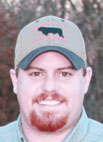
Ed and Lois Yoder came to Wesley, Ark., with their five now adult children: Emily, Karl, Kevin, Kendall and Mary Jo. They left their dairy farm in Indiana for a five-year stay in Ireland for mission work before coming to Arkansas in 2010.
Ed is a pastor and selected the area because the Mennonite Lighthouse of Faith Church in Huntsville. He preaches every fourth week and assumes his share of home and hospital visits, as well as outreach ministry. The four-pastor system at the church allows each pastor enough time to provide for their family and still pastor the church.
Before returning to the U.S., Ed bought 130 Jersey/Holstein heifers, which were cared for by his brother in Oklahoma until they arrived. Ed wanted the Jersey/Holstein mix to increase both butterfat content and heat tolerance during late summer grazing. As their DFA (Dairy Farmers of America) dairy evolved, Ed is now moving toward a heavier Holstein influence because his 170 milking cows are always under shelter.
“Heat is our biggest challenge. I don’t want fresh cows in the summer heat since high heat decreases milk production,” Ed explained.
Another heat stress relieving method is the needed use of fans and misters in the dairy barn during the 300-day milking period. These methods help the Yoder cows to produce an average of 50 pounds of milk per cow.
To maintain milking during the desired seasons, the breeding cycle is controlled with most calves born in September and October. The milking cycle ends July 1 when the cows are turned out to pasture for 60 days and have lower nutritional needs.
When the Yoders came to Arkansas, they purchased just under 700 acres of commercial cattle land in three parcels, much of it undeveloped or overgrown.
“We had to build from scratch,” Ed said. “There were no buildings so in the 2010-2011 winter, we built the dairy barn and milking parlor, in addition to adding and repairing fence.”
They finished on schedule, and the first set of calves was born the following April.
One result of sheltering the cows is an extensive need for high protein dairy nutrition. Toward this end, 100 acres is set aside for corn silage they chop themselves, 60 acres for sorghum silage, 70 acres for alfalfa hay and 50 acres for Bermuda hay. Farm produced feed is supplemented by 26 percent protein dried distillers grain and a custom mixed 14 percent corn protein and mineral mix.
Part of the Yoder acreage includes an irrigated 178-acre tract in Elkins where corn and alfalfa are raised.
The dairy’s water needs are met by a 690-foot well the Yoder’s dug during the construction phase on the farm. Water is stored in a 1,500-gallon tank and piped to the dairy barn.
The Yoder operation is definitely a family business. Ed serves as a general manager and works wherever he is needed while the eldest son Karl is in charge of the land, the related equipment and the feed regimen.
“It’s important to lower the protein levels when the cows are dry in order to prevent them from getting too fat and then having milk fever or calving issues,” Karl said.
Kevin is the herdsman and record keeper. He milks with his father, keeps the records, and does most of the vet work since he’s taken a short course in veterinary training. “We still have a vet to do preg checks because that is one area I am still learning,” Kevin said.
At this point, the trio of dairymen is looking toward a future where the sons will own the livestock while Ed and Lois will retain ownership of the land and facilities.
“My sons aren’t married yet and you never know what the future holds so remaining flexible is important,” Ed said.







